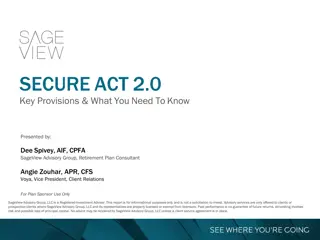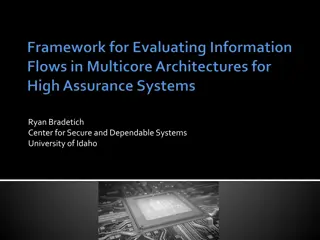
How Secure are Proximity Cards?
Are proximity cards safe for access control? We break down their security strengths and weaknesses to help you decide if they're right for your needs.
Download Presentation
Please find below an Image/Link to download the presentation.
The content on the website is provided AS IS for your information and personal use only. It may not be sold, licensed, or shared on other websites without obtaining consent from the author. Download presentation by click this link. If you encounter any issues during the download, it is possible that the publisher has removed the file from their server.
Presentation Transcript
How Secure are Proximity Cards? Have you ever wondered how those little plastic cards you wave in front of a reader allow you to enter secure buildings or pay for things? Those handy cards are called proximity cards or proximity badges, and they rely on a technology called RFID or radio frequency identification. While they make our lives more convenient, there are some important security risks to be aware of regarding prox card programmers. How Proximity Cards Work Proximity cards contain a tiny radio transponder chip and an antenna sealed inside the plastic card. When the card gets close to a card reader device, the reader emits a small radio frequency signal. This signal activates the transponder chip, which then transmits the card's unique identification code back to the reader. If the ID code matches an authorized code stored in the access control system's database, the door unlocks or the payment is approved. It's kind of like having a high-tech key that you don't have to put into any lock as you just need to get it close enough to the reader.
There are different frequencies that proximity cards operate on, with lower frequencies like 125 kHz and higher frequencies like 13.56 MHz being the most common. The frequency impacts the read range. However, lower frequencies have shorter read ranges of just a few inches, while higher frequencies can be read from several feet away. Read More Articles: Appliance Maintenance in Summer to Avoid Breakdowns Types of Proximity Cards There are three main categories of proximity credentials: 1. Proximity Cards: The standard plastic card format, about the size of a credit card. Moreover, easy to carry but can get lost or stolen. 2. Proximity Key Fobs: The transponder is built into a small plastic fob that can attach to a keychain. Further, it is harder to lose but easier for someone to surreptitiously read if it's always out. 3. Proximity Stickers: Adhesive stickers with the RFID transponder embedded. Additionally, it can be attached to phones, ID badges, etc. Most importantly, the card is inexpensive but not transferable once stuck. These different form factors allow organizations to choose the right proximity credential for their risk profile and user needs. The Security Risks While proximity cards are very convenient, there are some significant security vulnerabilities to be aware of: 1. Ease of Copying: Attackers can read the ID code from a proximity card and create a clone that can bypass the system with relatively inexpensive equipment. Some higher-security cards use encryption to prevent cloning, but many don't. 2. Location Tracking: The continual radio transmissions from the cards make it potentially possible to track people's movements if enough card readers are installed. However, there are privacy implications.
3. Tailgating/Piggybacking: If someone is holding a door open, unauthorized people could slip in behind the person with the proximity card, bypassing security. 4. Physical Risks: Proximity cards can be lost, stolen, or damaged fairly easily since people carry them everywhere. The cards could end up in the wrong hands. 5. Long Read Ranges: For higher frequency, longer-range proximity cards, it may be possible for someone to secretly read the card's signal from a distance without the owner knowing. 6. No Expiration: Unlike some other card technologies, most basic proximity cards don't expire or deactivate themselves automatically after a set period. 7. Transaction Logs: Proximity systems may not keep detailed audit logs of who entered where and when. This could be a liability during incident investigations. So while proximity cards are very user-friendly, there are some security tradeoffs to consider depending on the risks an organization faces. Read More Articles: A Guide to New York City's Neighbourhoods Improving Proximity Card Security Since proximity card technology has been around for decades, there are some established best practices to help improve its security: 1. authentication between the card and reader, and other security controls can mitigate many vulnerabilities. Upgrades: Using more advanced smart cards with encryption, mutual 2. Combination Technologies: Combining proximity with other factors like PINs, biometrics, or mobile credentials creates multi-factor authentication that's harder to bypass. 3. Limited Read Ranges: Switching to lower frequency cards with shorter read ranges limits opportunities for skimming or unauthorized long-distance reads.
4. Rotating Card IDs: Having the cards transmit a different ID code each time makes them harder to clone and contributes to privacy. 5. Logging and Auditing: Meticulously logging each card use and entry event enables better forensics and incident response. 6. End-User Education: Training people on proximity card best practices like shielding/ deactivating cards when not in use can reduce many risks. 7. Physical Security: Integrating proximity with other physical security controls like tailgate detection, CCTV monitoring, and mantraps creates additional layers. So while no technology is 100% secure, following security best practices and using the latest card technology can help mitigate many of the biggest risks that basic proximity cards face. The Future of Proximity While proximity card tech may seem a bit dated in our mobile era, there are ongoing efforts to modernize and secure it: Mobile Credentials: Instead of carrying a separate card or fob, your smartphone can become your RFID credential using specialized apps and hardware. This reduces the risk of losing cards. Bluetooth Proximity: Some new systems use Bluetooth Low Energy rather than RFID, enabling smartphones to open doors from a short distance with encryption and other security benefits. Biometrics Integration: Combining proximity with fingerprint or facial recognition allows for multi-factor authentication directly on the credential itself. Ultimately, while proximity cards have been around for decades, the underlying concept of carrying a "token" or ID badge to access areas isn't going away anytime soon due to its convenience. However, the prox card technology will likely continue evolving to make it more secure and integrated with our mobile-centric world.
The Bottom Line Proximity cards have become an advanced technology for secure access and payments due to their convenience. No system is perfect, but using the latest proximity smart card technology combined with other authentication factors can help make proximity cards reasonably secure for most applications. At Bristol ID Technologies, we pride ourselves on our relentless commitment to excellence and over four decades of experience in identification technology. Our dedicated team of experts is here to provide you with innovative and secure solutions for all your identification and access control needs. Explore our 26-bit proximity cards and PVC proximity cards, designed to offer superior reliability and efficiency. Site Article: How Secure are Proximity Cards?
















































